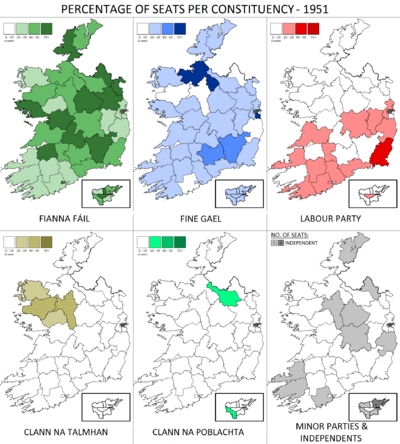Irish general election, 1951
|
|
|||||||||||||||||||||||||||||||||||||||||||||||||||||||||||||||||||||||||||||||||||||||||
|---|---|---|---|---|---|---|---|---|---|---|---|---|---|---|---|---|---|---|---|---|---|---|---|---|---|---|---|---|---|---|---|---|---|---|---|---|---|---|---|---|---|---|---|---|---|---|---|---|---|---|---|---|---|---|---|---|---|---|---|---|---|---|---|---|---|---|---|---|---|---|---|---|---|---|---|---|---|---|---|---|---|---|---|---|---|---|---|---|---|
|
|||||||||||||||||||||||||||||||||||||||||||||||||||||||||||||||||||||||||||||||||||||||||
|
|
|||||||||||||||||||||||||||||||||||||||||||||||||||||||||||||||||||||||||||||||||||||||||
|
146 of 147 seats in Dáil Éireann 74 seats were needed for a majority |
|||||||||||||||||||||||||||||||||||||||||||||||||||||||||||||||||||||||||||||||||||||||||
| Turnout | 75.3% | ||||||||||||||||||||||||||||||||||||||||||||||||||||||||||||||||||||||||||||||||||||||||
|
|||||||||||||||||||||||||||||||||||||||||||||||||||||||||||||||||||||||||||||||||||||||||

Percentage of seats gained by each of the five biggest parties, and number of seats gained by smaller parties and independents.
|
|||||||||||||||||||||||||||||||||||||||||||||||||||||||||||||||||||||||||||||||||||||||||
|
|||||||||||||||||||||||||||||||||||||||||||||||||||||||||||||||||||||||||||||||||||||||||
The Irish general election of 1951 was held on 30 May 1951. The newly elected members of the 14th Dáil assembled at Leinster House on 13 June when the new Taoiseach and government were appointed.
The general election took place in 40 parliamentary constituencies throughout Ireland for 147 seats in the lower house of parliament, Dáil Éireann.
The general election of 1951 was caused by a number of crises within the First Inter-Party Government, most notably the Mother and Child Scheme. While the whole affair, which saw the resignation of the Minister for Health, Noël Browne, was not entirely to blame for the collapse of the government it added to the pressure between the various political parties. There were other problems facing the country such as rising prices, balance of payments problems and two farmer TDs withdrew their support for the government because of rising milk prices.
Although the first inter-party government was now coming to an end it had a number of achievements. It proved that the country could be led by a group other than Fianna Fáil. It also provided a fresh perspective after sixteen years of unbroken rule by that party.
The coalition parties fought the general election on their record on government over the previous three years, while Fianna Fáil argued strongly against coalition governments.
The election result was inconclusive. Fianna Fáil's support increased by 61,000 votes, however, the party only gained one extra seat. The coalition parties had mixed fortunes. Fine Gael were the big winners increasing to forty seats. The Labour Party patched up its differences with the National Labour Party and fought the election together but in spite of this the party lost seats. Clann na Poblachta were the big losers of the election. Three years earlier the party was a big political threat, but now the party was shattered.
...
Wikipedia



